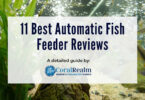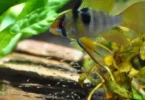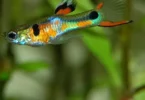Last Updated on April 24, 2023 by Coral Realm
In this complete guppy care guide article, we’ll be discussing the general care you need to know when owning guppies; this includes diet, housing, tank mates, maintenance and much more. Guppies are one of the most common species to be kept in a home aquarium, usually housed with compatible species to create a beautiful community tank.
Guppies are freshwater fish that come in all shapes, sizes and colors; with an overall number of 300 varieties of guppies known to exist. They are one of the easiest species to care for and are not known to cause any issues in community tanks due to their peaceful nature.
IN THIS ARTICLE
Complete Guppy Care Guide
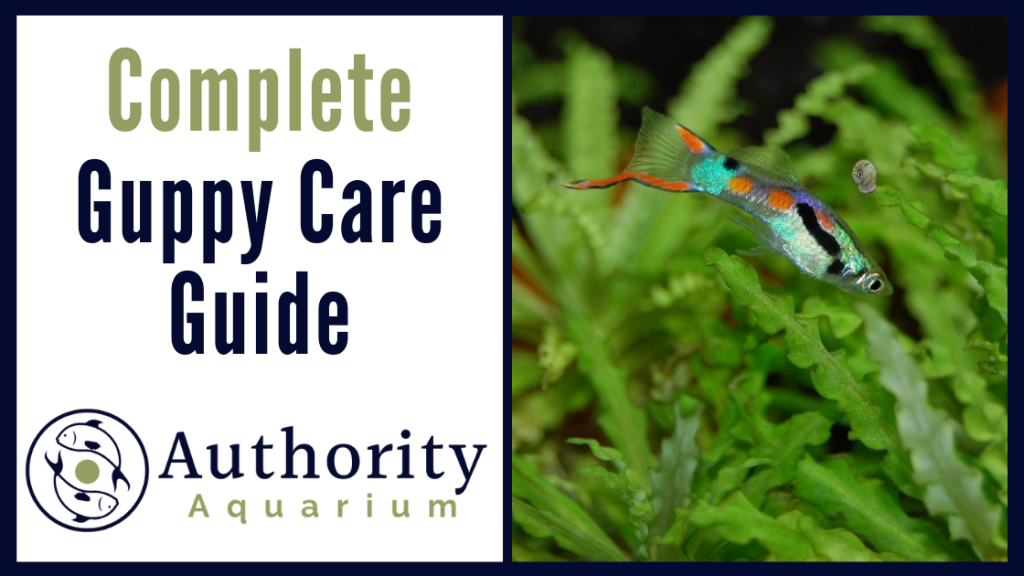
Housing:
In order to keep your guppies happy and healthy, they need enough space to roam around in the fish tank – guppies like to be kept together and should be housed with at least 3 in one group, however they will thrive off of as many as possible. These guppies should have at least one gallon to themselves, however more is ideal; for example, if you are housing 5 guppies alone they should be in a minimum of a 5 gallon tank; and the minimum size for a school of guppies is 20 gallons. This would give them enough space to move around, however giving them a bigger tank is ideal, guppies are relatively playful and will thrive in a large aquarium.
Many new fish owners believe that the smaller the tank the easier it is to maintain; this is not the case as larger tanks are actually far easier to maintain due to them producing algae much slower than small tanks, meaning you don’t have to clean them as often. It also takes much longer for ammonia to appear in larger tanks, meaning that you will have time to notice this rise and react, whereas smaller tanks will feel the effect immediately and could potentially harm your fish.
When deciding how to house your guppies, you need to take into account the intentions of keeping these fish, whether they’re for breeding purposes or just general pets. You also need to think about the genders of the guppies you’re keeping, as housing several males and females together will often result in them breeding and multiplying pretty quickly – this can often be a problem for new guppy owners as they’ll be faced with too many guppies that their tank can hold. Therefore, this needs to be reviewed and adapted depending on how many you want to keep.
If your guppies are for general pet ownership, they should be kept in a 20 gallon and above tank that has substrate, plants and hides whereas breeding tanks do not need substrate to ensure an easy cleaning schedule. Breeding tanks should contain floating plants for the fry to hide in.
Water conditions and temperature:
Their tank should replicate their natural habitat of the warm South American waters, it is important to do to provide them with their natural environment. This is achieved by ensuring that their tank is set up correctly and that any harmful bacteria’s are converted into beneficial ones, this can be done by ensuring that water is cycled appropriately.
To ensure your tank is correctly set up you will need a filter, an aquarium heater, an LED light and a thermometer; the size of these items will come down to the size of your tank. Filters such as HOB filters are best for aquariums of around 1000 gallons and under, whereas external filters such as canister filters like the Eheim Classic External are more suitable for those over 100 gallons – to find the best equipment for you please see our other articles, on Best Aquarium Heaters, the Best LED Lighting and the Best Aquarium Thermometers.
Guppies should be kept in waters between 75 to 82 degrees Fahrenheit (23-27 degrees Celsius), this can be monitored using the aquarium thermometer and changed using the heater if the temperatures become too cold or too warm. The thermometer should be placed at the opposite end of the tank to the heater to ensure that the water is heated evenly.
Regarding pH levels, guppies should be living in conditions that have a pH of 7 – 7.2, however guppies can tolerate levels of 5.5-8.5. This can be monitored using chemical test strips or chemical test kits. See below for our recommend testers:
Aquarium test strips
These water test strips are a quick and easy alternative to the master test chemical kits, complete with four strips and a chemical chart. One of these strips is to be placed into the water for a short amount of time and the colors on the strip should then be compared to the color chart – this will then accurately tell you the levels of pH, nitrite, nitrate carbonate and general water hardness.
Master test kit
This master kit is a more advanced alternative to the testing strips, with 7 bottles of testing solutions, 1 color card and 4 glass tubes. This kit will measure the pH, high range pH, ammonia, nitrite and nitrate carbonate. This kit may give you a more accurate result, however there is more of a risk of disrupting the process by putting too many or too little drops in the test tubes.
Feeding and diet:
Guppies are omnivorous fish that consume both plant and animal matter, they are usually given plant-based food that contains the necessary nutrients as well as algae from their captive environment; however, they can also be given live foods such as bloodworms, shrimp, fruit flies and mosquito larvae.

Being top feeders, guppies consume their food at the top of the water column, also known as the pelagic zone. They are usually seen in large schools that stay close together when catching the food, they will feed on commercial floating flakes such as the tetra pro color flakes.
These will float on the surface of the water for a while before beginning to sink, guppies may follow the food when it first begins to sink however, they will not usually consume their food at the middle or bottom of the tank.
Top feeders have evolved so that their mouths have become upturned in order to efficiently capture the floating food, unlike bottom feeders that usually have longer mouths that point towards the ground.
See our article on what feed your tropical fish here:
Feeding techniques:
Scatter feeding is where the food is spread around the aquarium to allow the fish to catch and consume it by themselves. For guppies, these will be floating flakes or slow sinking pellets as they will not consume the food at the bottom of the tank if the food was to sink immediately.
Scatter feeding gives the fish a choice of food to consume as well as replicating their natural environment, as in the wild they would consume small particles of food in the water. However, this strategy has a higher risk of contaminating the water than other strategies to as the food will dissolve into the water if it is not eaten, resulting in the owner not being able to physically see the rotting food; therefore the aquarium may not be cleaned and diseases may occur.
How to scatter feed:
- Purchase the desired food for that species
- Collect the food to feed the fish, for guppies an example of this would be the Tetra Pro Colour flakes
- Open the lid of the tank and put in 1-2 pinches of food into the water
- Allow the guppies to consume the floating food and observe to ensure there are no fighting behaviours
- Remove any excess food from the tank to prevent diseases and parasites, as well as to protect and maintain the quality of the water
Drip feeding involves a tube contraption that pours the liquid or dissolved food into the tank at a slow rate. This is an unusual method usually used for fry that require food little and often in order to develop correctly. This method is effective when caring for fry as it allows you to have control over what they are consuming, as giving them large pellets or flakes makes it difficult for them to consume and they may not gain the essential nutrients that they need to grow.
How to use a drip feeder:
- Get a 1/16 inch tube to be inserted from the fish tank into the infusoria
- Mix the chosen food into the mixture and allow the tube to fill itself
- The mixture will drop into the water at around one drip per minute
Guppies should be fed one to two times a day in the morning and evening and only fed as much as they can consume in two minutes, they should be provided with a variety of food types as living on one can lead to nutrient deficiencies. The age of your guppies needs to be taken into account when feeding them, fry (new-born guppies) should be fed little and often, they benefit from flake food that has been broken down into tiny pieces.
Adult guppies are able to consume all types of food such as flakes, crisps, some pellets and other supplements like vegetables. Alternating between flake food, live food and vegetables will give them the most nutritious diet and will be the most beneficial way to keep them healthy and away from diseases.
Guppy Tank mates:
Even though there are many compatible tank mates for guppies to be housed with, the best option to keep them happy in their enclosure is to house them with multiple guppies. Guppies love to stay in large groups and the more there are the healthier their behaviors will be, however this needs to relate to the size of your tank – the more guppies you have the bigger the enclosure needs to be.
Due to the rapid breeding rate of guppies, we recommend housing males and females separately, most owners choose to keep a group of males together due to their bright colors and long, impressive tails – however females make just as good pets. If you choose to house both females and males together, we recommend keeping them at a 2:1 ratio, this will prevent the males becoming too dominant and carrying out aggressive mating behaviors towards the females.
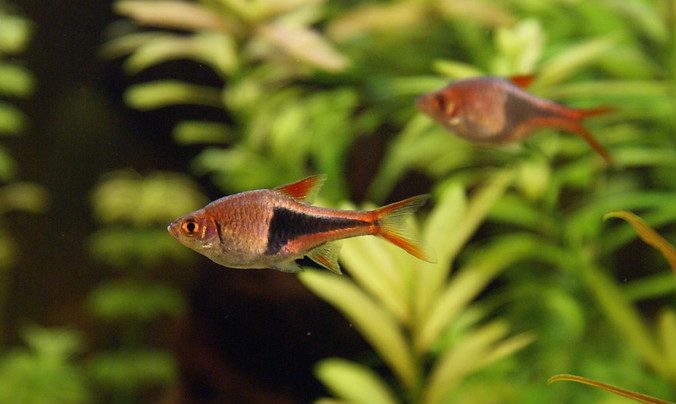
Harlequin Rasboras, a great tank mate for guppy fish Credit: Stefan Maurer (Flickr)
Guppies can be housed with other top and middle feeding community fish such as molly fish, platies, swordtails, Gouramis, Harlequin Rasboras and non-aggressive tetras. They also live peacefully with bottom dwellers such as plecostomus, loaches, snails, shrimp and catfish; as these species live at the bottom of the aquarium and are non-aggressive, they will keep themselves distanced from the guppies and won’t cause any problems.
African Dwarf Frogs also make great tank mates for guppies if you are looking for a different aquatic animal to keep, however they can be difficult during feeding time as the guppies will consume the food much faster than the frog.
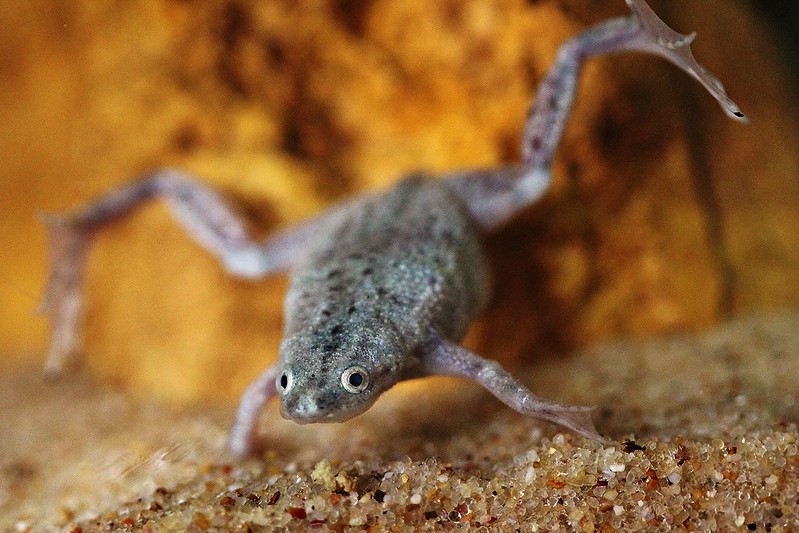
African dwarf frogs are a great option for guppy tank mates if you are looking for something different! Credit: Renee Grayson (Flickr)
Fish to be avoided when keeping guppies:
Larger, aggressive fish should be avoided as many will not hesitate to see the guppies as food. Angelfish can be housed with guppies if they are small, as large angelfish will be prone to consume the guppies. Cichlids should also be avoided due to their large size, aggressive nature and territorial traits, they will regularly attack the guppies and cause both stress and diseases such as tail rot from aggressive behaviors.
Endler’s livebearers are not a suitable tank mate for guppies due to the high chance of cross breeding, even though the two species will get along, they are likely to breed and create weak offspring.
In conclusion, any large and aggressive species should be avoided.
Enrichment:
Like most fish, guppies love to hide amongst pants, explore new areas and find food wherever they can. When housing guppies as pets, it is important to include features such as hides, plants and food enrichment to allow them to exhibit their natural behaviors that they would carry out in the wild, this then helps to prevent stress which will then contribute to their health; avoiding any diseases.
Many fish owners often neglect the mental state of their fish due to their species, however fish both enjoy and require stimulation and things to do in their tank just as much as land animals do in their captive enclosures. So enrichment is an important part of guppy care. Not only does enrichment make your tank look lively and bursting with life, it will also keep them in a good condition ready for breeding season, as well as keeping them happy, healthy and their colors bright.
Enrichment can come in many forms, it doesn’t always have to mean training your guppy to swim through hoops or come when called; enrichment could simply be changing their food pattern or lighting. There are several methods of enrichment, these include:
Environmental enrichment – Changing the appearance or function of the aquarium for the fish to experience a new environment. This also includes installing Aquarium LEDs into the tank.
Food enrichment – Using new foods to allow them to use different feeding methods
Social enrichment – Adding compatible species to the aquarium to give the fish company and new interactions
Environmental enrichment is one of the most simplest ways to introduce enrichment to your guppies, it can include slightly adjusting the lighting intensity every few days or depending on the season to give a different atmosphere; or periodic changes to the exhibit such as putting in new logs, hides and plants to allow them to hide in new areas and experience different textures (this also prevents them from experiencing the same layout every single day).
There are some health and safety considerations when putting objects inside the aquarium – they should be big enough to prevent the fish from ingesting any decorations, they must also be strong and durable so that they don’t break and get ingested by accident, they should not contain any harmful chemicals that may contaminate the water, and lastly each and every item must be thoroughly washed before introducing them into the aquarium to remove any particles that may be on the items.
Here are some examples of what to include in your tank:
Logs and hides:
Invalid table id.Artificial plants:
Invalid table id.Live plants:
There are many species of live plants which will greatly enrich your tank and enhance guppy care. Live plants are important in any aquarium as they make the tank a lot more natural, and they provide shelter and places to explore. This will reduce stress and make guppy care a lot easier, and will make your guppies healthier. Both floating plants and rooted plants are perfect for guppy care.

Food enrichment is a great way to stimulate different feeding methods that guppies may use in the wild. This can include using live foods such as bloodworms, shrimp, fruit flies and mosquito larvae that will encourage their hunting abilities (these can be sourced from your local pet store or fish food provider); only put as many as your guppies can eat in one minute into the tank at once.
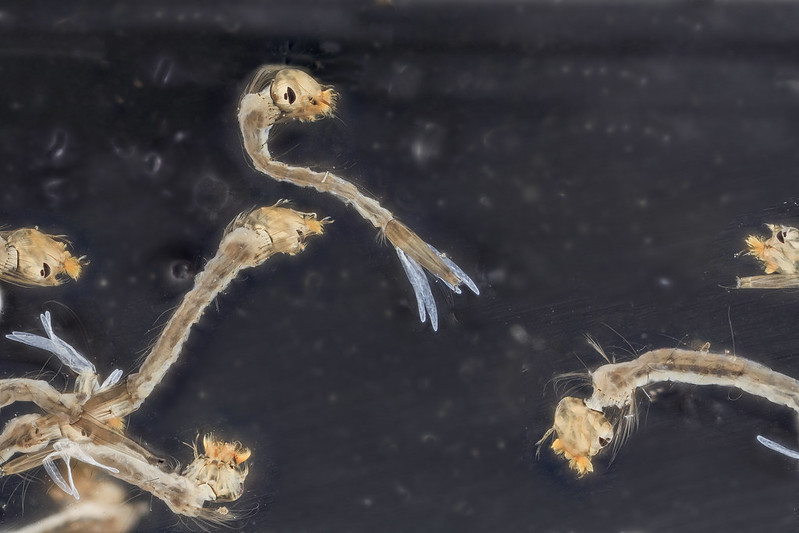
Mosquito larvae are a perfect way to feed your guppies more nutrients, and also to enrich their environment with live foods
Whilst guppies can survive on commercial pellets and flake food, they are omnivorous animals and can also benefit nutritionally from fruit and vegetables – this is a great form of food enrichment as it will encourage them to forage for their food and use their mouths in a different way to peck at the fruit rather that consume floating foods.
Foods suitable for guppies include cucumber, bananas and grapes; these can be sliced into small pieces and placed into the tank in your preferred way, this can be attached the glass, left to sink or held in place to the substrate. Only feed fruit as a treat and up to twice a week as a maximum. Placing the food at the front of the tank is also a great way to encourage your guppies to swim in the open and leave their hiding spots, which is ideal for aesthetic purposes when using guppies for appearance reasons in your home.
Guppy Breeding:
When keeping guppies for breeding purposes, many factors need to be taken into account. Including how many you will keep together, how you will aid the pregnancy, enrichment you will use, the size of the tank and how you will care for the fry once they are born.
An appropriate breeding set-up should be created for easy maintenance, to prevent any harmful bacteria from growing. A small tank will provide enough space for the adults and the fry, a tank of at least 5 gallons to 15 gallons will be enough space for a breeding enclosure. Internal filters will be appropriate for a smaller tank and a small internal sponge heater can also be placed inside the tank to raise the temperature to the desired number, this filter should have plenty of airflow as this aids in the growth of the fry.
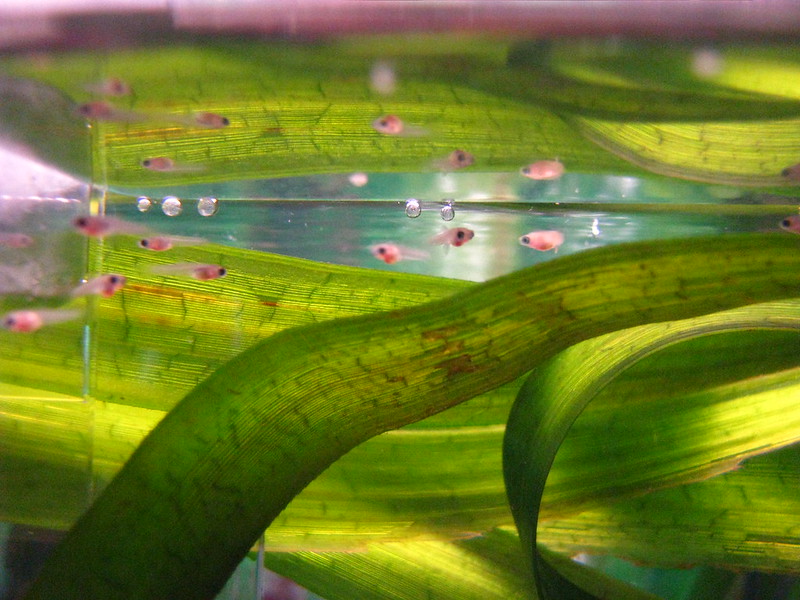
Guppy fry. Credit: Falashad (Flickr)
Too many decorative features need to be avoided, however floating plants or grass is ideal for giving the guppy a place to lay their offspring, this will also allow the fry to hide amongst it. Guppies give birth to live offspring that will venture out by themselves immediately, there is no parent to offspring bonding that takes place, and the mother should be removed as soon as possible to avoid her eating her offspring. The fry grows inside the guppy before being born and will feed off the internal egg sac, meaning they are born well nourished.
The young guppies can then be sexed and placed into appropriate tanks to avoid unwanted inbreeding. Males have bright and colorful tails whereas the females are more transparent, males also have a modifies anal fin that is longer and more narrow than that of the female. Males are usually smaller in size and females have a dark spot just behind their anal fin.
Common health issues seen in guppy care:
Guppies are not highly sensitive fish and can survive in a range on conditions, making them an easy species to keep. However, due to their long and delicate tails they are prone to infections and injuries. The most common issues are White Spot Disease, fin and tail rot and a bend in their spine.
See our articles on White Spot Disease and Fin Rot to find out more information on the causes and treatments.
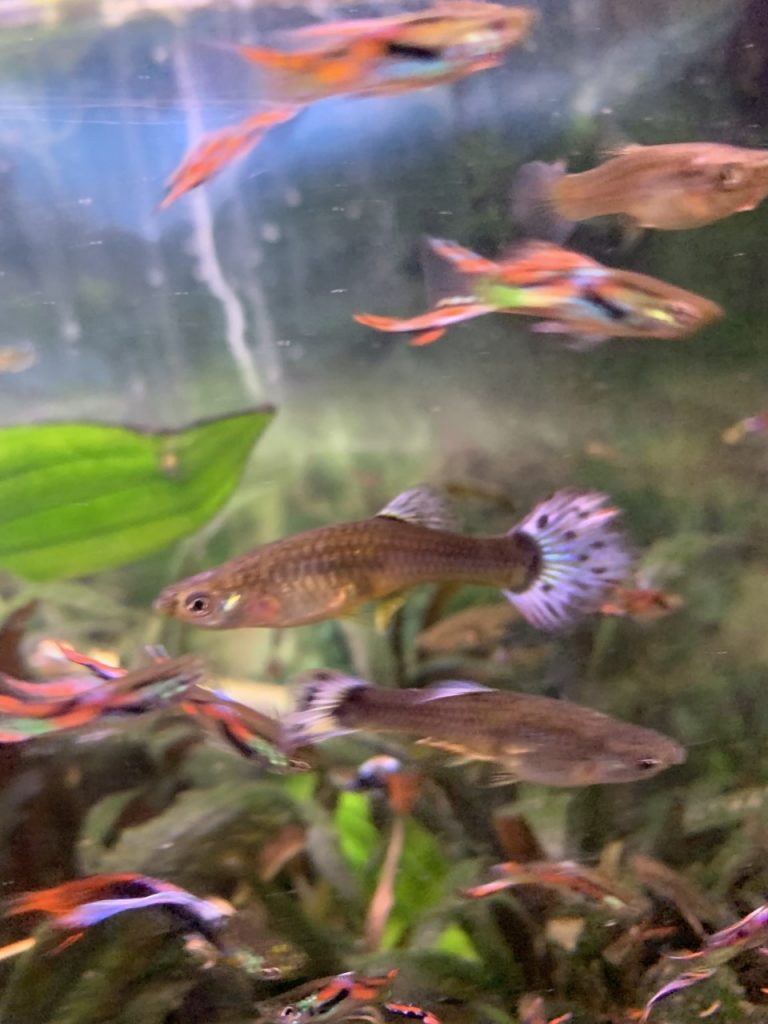
A Guppy with a mild case of spinal deformity. See the slight curve in the spine after the dorsal fin.
A bend in their spine is often caused by inbreeding, incorrect diet and hereditary factors. To prevent these issues from occurring:
- Ensure that the water conditions are correct
- Clean the tank regularly
- Only house them with compatible tank mates, others can be aggressive and will often nip and rip the guppy’s tails
- Keep them in an appropriate tank size, do not keep a big group of guppies in a small tank, this will cause overcrowding
- Feed them a complete diet with occasional supplemented treats
Are guppies the right fish for you?
Guppies are the perfect fish for beginners due to their easy maintenance and their ability to adapt to different conditions, they are peaceful and get along with many other species. Their bright tails also add color to an aquarium and are great for keeping in aquariums that are in a public place or on show. They are also appealing to experienced fish owners and breeders due to the high demand from fish lovers.
By keeping their tank clean, giving them a flexible diet and compatible tank mates, guppies will provide you with active and colorful movement in your tank.







